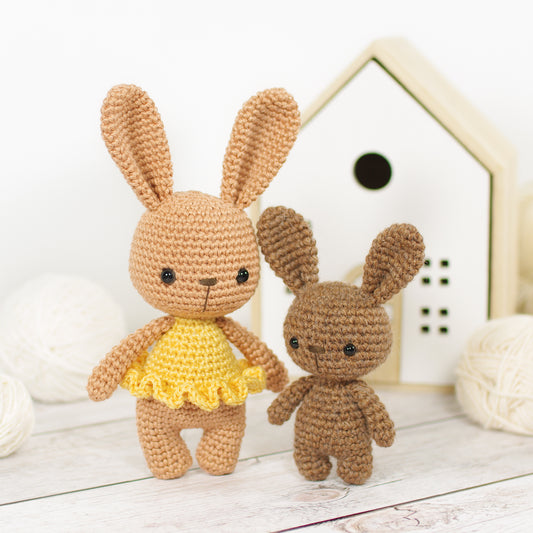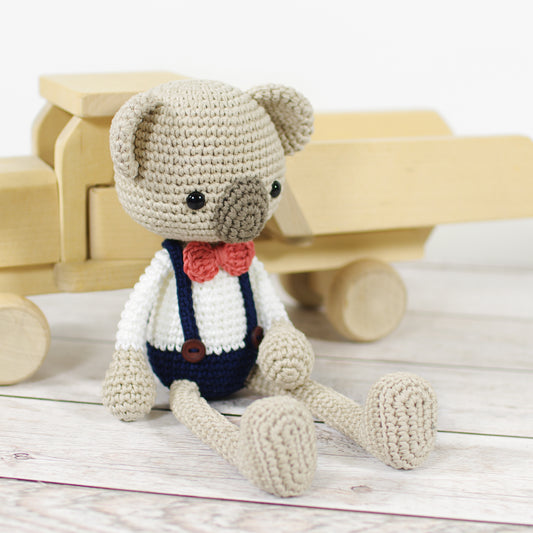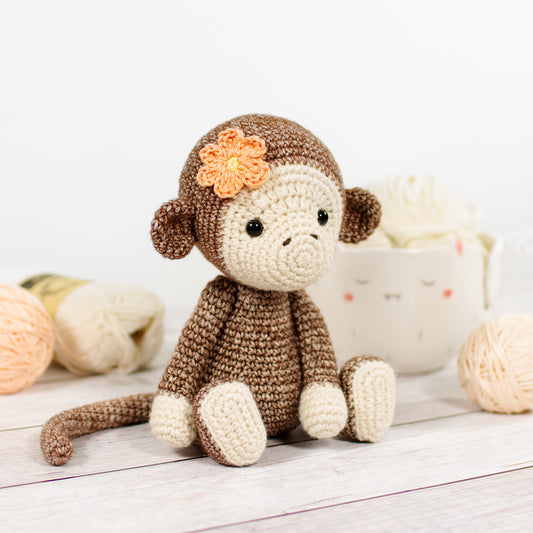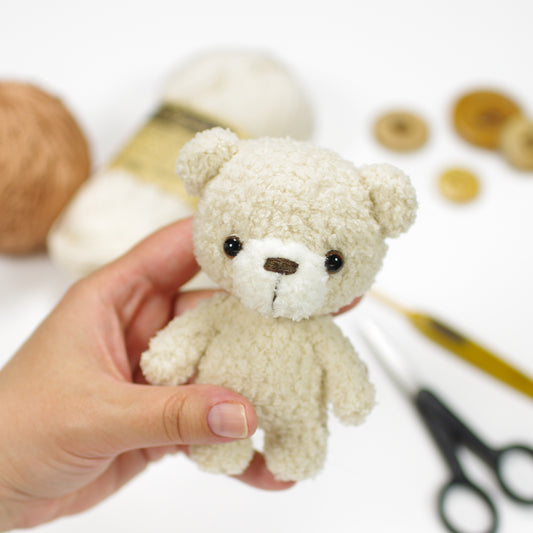One great thing about crocheting toys is that the exact size is rarely important, which gives you the opportunity to experiment with all kinds of different yarns - use bulkier yarn (or crochet holding multiple strands of yarn together) and you'll get a larger toy, use finer yarn and you'll get a smaller toy, pick eyelash yarn for a fuzzy look, cotton or viscose for a nice smooth surface, alpaca or wool for a more natural and rustic feel. With just one pattern you can create so many different looks.

If you pick a yarn that is significantly lighter or heavier (i.e. finer or thicker) than the one listed in the pattern, you'll also need to adjust the size of the crochet hook and eyes, noses, joints or any other details you want to use, more about it below.
Choosing the yarn
I always start by choosing the yarn first and then adjust all other details according to that. You can pick any yarn you like, just keep in mind that softer yarns like wool, alpaca, angora or acrylic are a lot easier to work with than tougher yarns like cotton, linen or hemp. But whether you prefer very fine and delicate details or are more of a chunky wool kinda girl, most patterns work for both.
Tip! If you can't find a yarn that is thick enough, you can always crochet holding multiple strands of yarn together.
A good rule of thumb is: doubling the weight of the yarn will increase the size of your finished toy about 1.5 times. So, if you look at the yarn weight suggested in the pattern, you can estimate how your yarn choice will affect the size of the finished toy.
Choosing the crochet hook
If you change the weight of the yarn, you'll also have to adjust the size of the crochet hook. Take a look at the suggested hook size on the yarn label, but pick a hook that is at least a size smaller than the one listed on the label. I usually just try crocheting a few stitches with different hooks and then pick the smallest one I can still crochet comfortably with. This will give you a nice tight fabric that doesn't let the stuffing show through.
Eyes, noses, joints and other details
As mentioned above, doubling the yarn weight will change the size of your finished toy about 1.5 times. So, if you compare the weight of the yarn you chose to the one listed in the pattern, you can get a rough idea how you need to change the size of your eyes, noses or joints. But it's not exact, you'll just have to start crocheting and decide as you go.
And here are a few examples:

Both these stripy kitties are crocheted using this pattern.
The smaller cat is 22 cm (8 2/3") tall, I used:
- DK weight alpaca wool, 50g = 100m (50g = 109yd) / 8 ply / 11 wpi / 3: light.
- 2,50 mm crochet hook (US size 2/C).
- 12 mm (1/2") safety eyes.
The larger cat is 45 cm (17 3/4")tall, I used:
- Bulky wool and acrylic blend, 100g = 140m (100g = 153yd) / 12 ply / 7 wpi / 5: bulky.
- 4 mm crochet hook (US size 6/G).
- 18 mm (3/4") safety eyes.

All these teddy bears are crocheted using this pattern, from left to right:
The large fuzzy teddy is 35,5 cm (14") tall, I used:
- Sport weight acrylic yarn, 50g = 189m (50g = 207yd) / 5 ply / 12 wpi / 2: fine, and nylon eyelash yarn, crocheted holding them together. My tips for crocheting with fuzzy yarns here.
- For the muzzle and bottoms of the feet, I used bulky wool and acrylic blend, 100g = 140m (100g = 153yd) / 12 ply / 7 wpi / 5: bulky.
- 4 mm crochet hook (US size 6/G).
- 35 mm (1 1/2") joints for legs and 30 mm (1 1/5") joints for arms.
- 15 mm (2/3") safety eyes.
- 21 mm (4/5") safety nose.
The small beige teddy is 18 cm (7") tall, I used:
- DK weight cotton and linen blend, 112 m = 50 g (122 yd = 50 g) / 8 ply / 11 wpi / 3: light.
- 2,50 mm crochet hook (US size 2/C).
- 20 mm (4/5") joints for legs and 15 mm (2/3") joints for arms.
- 9 mm (1/3") safety eyes.
The large brown teddy is 33 cm (13") tall, I used:
- Bulky wool and acrylic blend, 100g = 140m (100g = 153yd) / 12 ply / 7 wpi / 5: bulky.
- 4 mm crochet hook (US size 6/G).
- 35 mm (1 1/2") joints for legs and 30 mm (1 1/5") joints for arms.
- 15 mm (2/3") safety eyes.
The small white teddy is 17 cm (6 2/3") tall, I used:
- Sport weight cotton, 50g = 125m (50g = 136yd), / 4 ply / 12 wpi / 2: fine.
- 1,75 mm crochet hook.
- 15 mm (2/3") joints for legs and 12 mm (1/2") joints for arms.
- 8 mm (1/3") safety eyes.

Both these teddy bear are crocheted using this pattern.
The smaller bear is 12,5 cm (5") tall, I used:
- DK weight cotton and linen blend, 50g = 112m (50g = 122yd) / 8 ply / 11 wpi / 3: light.
- 2,50 mm crochet hook (US size 2/C).
- 10 mm (2/5") buttons for leg joints and 8 mm (1/3") buttons for arm joints.
- 8 mm (1/3") safety eyes.
The larger bear is 20 cm (8")tall, I used:
- Bulky wool and acrylic blend, 100g = 140m (100g = 153yd) / 12 ply / 7 wpi / 5: bulky.
- 4 mm crochet hook (US size 6/G).
- 20 mm (4/5") joints for legs and 15 mm (2/3") joints for arms.
- 12 mm (1/2") safety eyes.
If you have any questions, do not hesitate to contact me or leave a comment below, I am always happy to help.






8 comments
How to use crocheting yarn to do toys
How to use crocheting yarn to do toys
How to use crocheting yarn to do toys
I’ve always wanted to ask this !!! can I interchange Himalaya dolphin yarn (velvety yarn )in a pattern.. does this tip pertain to that as well..? Like say if I want to use yarn art instead to make it much smaller
Hi Brandy,
I used the exact same pattern and didn’t change anything at all. The size difference is just due to the yarn I used – the thicker (or heavier) the yarn you use, the larger your finished toy will be.